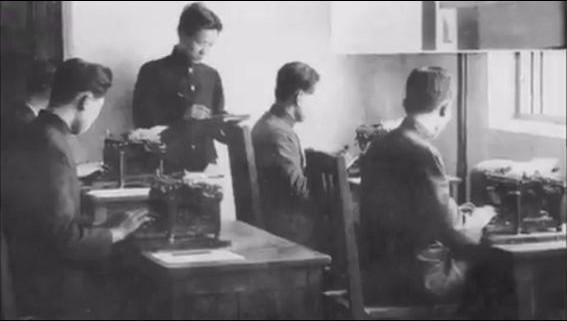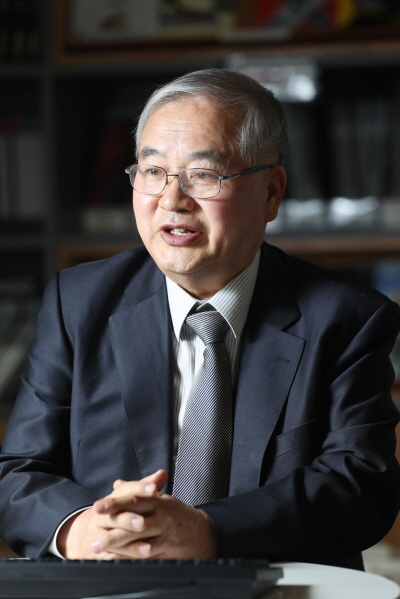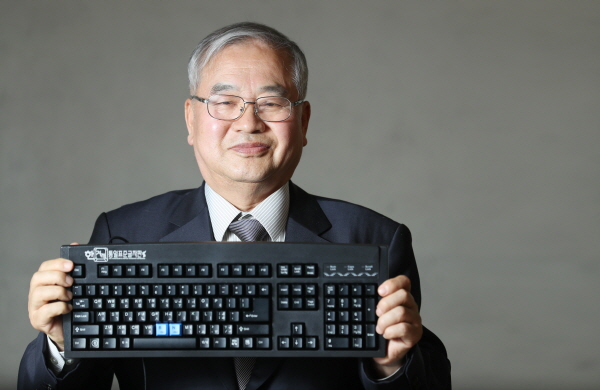Q: How do you assess the role and future of the unified Hangeul keyboard? A: After acquiring a Ph.D. in business administration from Yonsei University, I have devoted myself to doing research on the keyboards. I have spent more than 50 years in R&D on keyboards. I became keenly interested in the unified keyboard one year after I was named chairman of Special Computer Keyboard Committee of Korean Agency for Technology Standard in 2004. While traveling to North Korea for academic exchanges, I felt the necessity to create a unified keyboard in the event of national unification. Our Northern partner was “National Reconciliation Council” which was responsible for academic exchanges with South Korea. However, we accessed North Korea via the language information management society of Chinese-Koreans in China since it was difficult to travel to the North very often. It is hoped that the unified keyboard will become a stepping stone of national unification, while it may take time for the keyboard to be accessible in daily life.

Students of Chosun Christian College practice Korean typewriting (predecessor of Yonsei University). Q: How would you like to talk about the historical background of our typewriter and digital keyboard system? A: There are two experts in regard to Hangeul mechanization (installing Korean alphabet on the invented typewriter keyboard). They are Kong Byung-woo and Kim Dong-hoon. The first thing that President Park Chung-hee has done after creating the national science and technology exhibition in 1969 involved the integration of typewriters. The triple-set keyboard (consonants, vowels, Korean final consonants (bachim) developed by Kong Byung-woo was easy to use, while its characters were unattractive. The five-set keyboard of Kim Dong-hoon (consonants and long & short vowels) was attractive, albeit it was too slow in speed. A four-set keyboard also hit the market. However, the newly developed triple-set keyboard, with the addition of consonants and vowels, was considered more reasonable. Moreover, it was faster than the double-set keyboard that is readily available today. Eventually, both Kim Dong-hoon and Kong Byung-woo threw in the towel. I had to manage all related issues. I have started collecting Korean typewriters since. I became a high school teacher. I was urged to lead the national computer keyboard special committee by the Korean Agency for Technology and Standards. Soon, I embarked on a 160-million-won research project. As for the mobile Hangeul keyboard, C model developed by Samsung Electronics and N model created by LG Electronics were considered de facto standards in view of the market principles.

Chairman Cho explains how the keyboard has been developed. In November 2005, we finished basic research on the standardization of a miniature keypad-type layout. In 2007, we produced research reports regarding the keyboard layout for information technology, texts and office systems. We also adopted reports on the keys of the keypad (KS X ISO/IEC 9995-4, KS X ISO/IEC 9995-8). The history of digital keypad standardization lasting half a century is never short. One obvious fact is that while an effective and scientific layout method is important, it may be difficult to ignore market principles (de facto standards.) As a result, the adoption of multiple standards seemed reasonable. The announcement that developer Cho Kwan-hyeon would give up all patent rights related to the Cheonjiin keyboard model, which has become a de facto standard, was a watershed in the development of national standards. On this occasion, I sincerely hoped that this model would be in great demand as a global standard for digital keyboard. Q: Please tell us about China’s “Hangeul Project” and the mobile phone keyboard. A: It was reported in October last year that the Chinese-Korean information society in China will kick off a standardized keyboard layout project. China’s “Hangeul Project,” which calls for developing the method of Hangeul input on mobile devices including smartphones, has fueled anti-Chinese sentiments in Korea.

Chairman Cho, Sok-hwan of KAIM shows the keyboard he has developed. This incident reminded me of Joseon Dynasty scholar Choe Man-ri’s movement against Hangeul. Choe was an associate professor in the Hall of Worthies who spoke against the creation of Hangeul (then called Eonmun) together with other Confucian scholars in 1444. He made a submission that year to King Sejong against hangul. Part of the submission reads: “Our dynasty, from our ancestors, has followed the great and complied with the standards of China. Now we are of the same script and the same measure, it is detrimental to conformity to create a new orthography such as Eonmun.” The history of Hangeul standardization dates back to half a century ago. Today tens of millions of Hangeul computer users access the computer information processing keyboard. This keyboard had already been globally standardized. The sudden reports on China’s “Hangeul Project” have thrown Koreans and the political circles into confusion. Lee Kyung-sik edt@koreapost.com <저작권자 © 코리아포스트, 무단 전재 및 재배포 금지> * 한글판 링크 : http://pdf.koreapost.co.kr/36/3602.pdf |  지식정보화의 Vision
지식정보화의 Vision  지식정보화의 Vision
지식정보화의 Vision